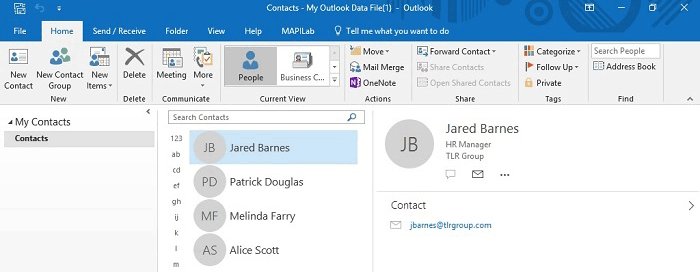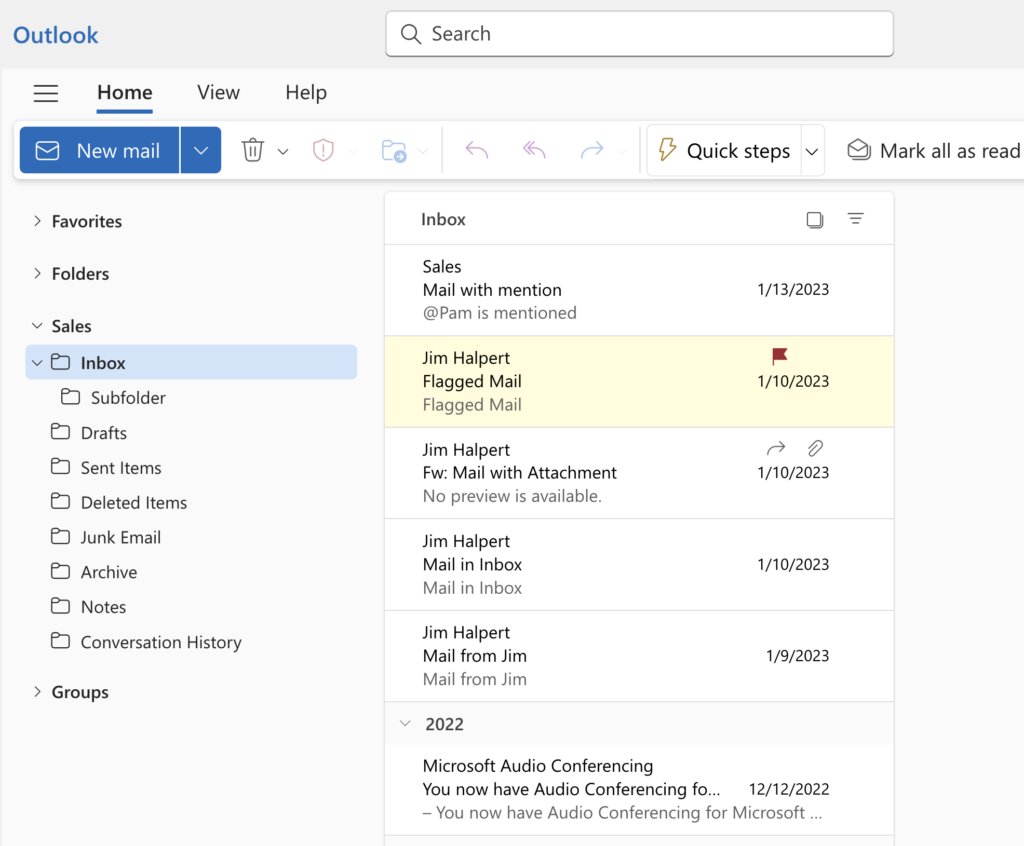Distribution Groups vs. Shared Mailboxes in Outlook: When To Use What

Table of contents
Efficient email management is crucial for clear and timely communication in any organization. Whether you’re handling customer inquiries, coordinating with team members, or sending internal announcements, how you manage emails can significantly impact your workflow.
In Microsoft Outlook, distribution groups and shared mailboxes offer distinct ways to enhance email management.
Distribution groups enable one-to-many communication, allowing you to send messages to a large group of recipients simultaneously. On the other hand, shared mailboxes provide a common inbox where multiple team members can access and manage emails collaboratively.
But what exactly are these tools, and how do they differ? More importantly, which one is right for your business needs—a distribution group or a shared mailbox?
In this article, we’ll explore the key differences between distribution groups and shared mailboxes in Outlook, helping you understand their unique functionalities and benefits.
Table of Contents
- What are Distribution Groups in Outlook?
- Advantages of Distribution Groups in Outlook
- Disadvantages of Distribution Groups in Outlook
- What are Shared Mailboxes in Outlook?
- Advantages of Shared Mailboxes in Outlook
- Disadvantages of Shared Mailboxes in Outlook
- Key Differences Between Distribution Groups and Shared Mailboxes
- When to Use Distribution Groups in Outlook?
- When to Use Shared Mailboxes in Outlook
- Choosing the Right Tool for Your Business
What are Distribution Groups in Outlook?
Let’s start by understanding what distribution groups are in Outlook. In the simplest terms, a distribution group is a collection of email addresses grouped under a single alias.
When you send an email to a distribution group in Outlook, the email is automatically sent to all members of the group. This is particularly useful for sending announcements, newsletters, or any message that needs to reach multiple people at once.

Primary Use and Functionality
Distribution groups in Outlook are designed for one-way communication. They are ideal for broadcasting messages to a large audience without expecting a reply. Think of it as a megaphone—you send out information, but you’re not set up to receive feedback through the same channel.
This makes them perfect for internal updates, company-wide announcements, or marketing emails where the goal is to disseminate information quickly and efficiently.
Setting Up And Using a Distribution List
Prerequisite: You need administrative privileges in your email system.
Steps:
1. On the Navigation bar, select People.
2. Go to Home and click New Contact Group.
3. In the Contact Group box, enter a name for the group.
4. Select Add Members and choose one of the following options:
– From Outlook Contacts
– From Address Book
– New E-mail Contact
5. Add people from your address book or contacts list and click OK. You can hold down the Ctrl key to select multiple members.
6. Choose Save & Close.
Using the Distribution List: When composing a new email, you can type the name of the distribution list in the “To” field and send the email to all members at once.
Advantages of Distribution Groups in Outlook
1. Simplicity: Setting up a distribution group in Outlook is straightforward. You just need to compile the email addresses and assign them to a group alias.
2. Efficiency: Saves time by sending a single email to multiple recipients simultaneously rather than individually.
3. Consistency: Ensures that all members receive the same information at the same time, maintaining uniformity in communication.
Disadvantages of Distribution Groups in Outlook
1. Lack of Collaboration: Distribution groups in Outlook are not designed for interactive communication. They don’t support responses, which can limit discussion and feedback.
2. Visibility Issues: There’s no way to track who has read or responded to the emails, as every email is sent to individual inboxes.
3. Inbox Congestion: If multiple members reply-all to the email, it can lead to inbox congestion and confusion, especially if replies are meant for specific individuals rather than the whole group.
All in all, distribution groups in Outlook are a powerful tool for one-way communication, ideal for disseminating information to large groups efficiently. However, they fall short when it comes to collaborative tasks and managing interactive email threads.
What are Shared Mailboxes in Outlook?
Now that we’ve covered distribution groups let’s dive into shared mailboxes in Outlook. A shared mailbox is essentially a single email inbox that multiple users can access and manage. Unlike distribution groups, which are great for sending out messages, shared mailboxes excel at sending, receiving and collaborating on emails.

Primary Use and Functionality
Shared mailboxes in Outlook are designed for two-way communication and teamwork. They allow multiple users to send, receive, and manage emails from a central location. Imagine it to be a communal workspace where team members can collaborate on customer inquiries, internal tasks, and more. Everyone with access can see incoming emails, respond to them, and even send emails from the shared address.
Manage Your Outlook Shared Mailbox Efficiently
Advantages of Shared Mailboxes in Outlook
1. Collaboration: Perfect for teams that need to work together on emails. For example, a customer support team can share a single [email protected] mailbox, ensuring that all customer inquiries are addressed promptly.
2. Centralized Management: Emails are stored in one place, making it easier to manage and track communication. No more wondering if someone has replied to an important message.
3. Consistency: Emails sent from a shared mailbox come from a single address, providing a consistent point of contact for external communications.
4. Reduced Dependencies: If one team member is out of the office, others can still access and respond to emails, ensuring continuous workflow and no delays in communication.
Disadvantages of Shared Mailboxes in Outlook
1. Complexity: Setting up and managing a shared mailbox in Outlook can be more complex compared to a distribution group. It requires careful configuration of permissions and access levels.
2. Privacy Concerns: Since multiple people have access, it’s crucial to manage permissions properly to prevent unauthorized access to sensitive information.
3. Risk of Collision: Multiple team members might attempt to respond to the same email simultaneously, leading to confusion. That’s where tools like Hiver that work on top of Outlook can help. It offers features like collision detection that alert users when someone else is drafting a response to an email.
In summary, shared mailboxes in Outlook are a fantastic tool for teams that need to collaborate on email communications. They provide a centralized and consistent way to manage and respond to emails, fostering teamwork and efficiency. However, they do come with some challenges, such as managing permissions and preventing response collisions.
Key Differences Between Distribution Groups and Shared Mailboxes
Here’s a comprehensive table that highlights the key differences between distribution groups and shared mailboxes in Outlook. This table will help you understand the unique functionalities and advantages of each tool.
| Feature | Distribution Groups | Shared Mailboxes |
|---|---|---|
| Purpose & Functionality | One-way communication: sends emails to multiple recipients | Two-way communication: allows multiple users to send, receive, and manage emails |
| Primary Use | Sending announcements, newsletters, and updates | Collaborative tasks such as in customer support and sales |
| Collaboration | Limited; not designed for interactive communication | High; supports team collaboration on email management |
| Email Management | each recipient receives their own copy of the email | Centralized management; all emails are stored in a single, shared inbox |
| Permissions & Security | Minimal control; basic security settings | Granular control; robust security features with specific permissions for different users |
| Visibility | Low; no tracking of email responses or interactions | High; allows team members to see who is working on which emails |
| Sending & Receiving Emails | Sends emails to a group of recipients’ individual inboxes | Centralized sending and receiving from a single shared email address |
| Storage & Archiving | Emails are stored in individual recipients’ inboxes | Centralized storage and archiving, making it easier to manage and access past communications |
| Setup Complexity | Simple and quick to set up | More complex; requires careful configuration of permissions and access levels |
| Use Case Examples | Company-wide announcements, marketing emails | Customer support teams, project teams, sales teams managing client communication |
| Potential Challenges | Risk of inbox congestion, lack of collaboration | Risk of collision, privacy concerns, management complexity |
When to Use Distribution Groups in Outlook?
Now that we’ve outlined what distribution groups and shared mailboxes in Outlook are and how they differ, let’s dive into the scenarios where distribution groups shine. Distribution groups in Outlook are particularly useful for one-way communication, making them ideal for specific use cases within an organization.
Scenarios Ideal for Distribution Groups in Outlook
- Company-Wide Announcements: Use distribution groups in Outlook to send important updates or announcements to everyone in the organization. This ensures simultaneous delivery without the need for individual emails.
Example: An HR manager can send policy updates to all employees at once using a distribution group. - Marketing Communication and Newsletters: Outlook distribution groups are perfect for sending newsletters or promotional emails to a large audience, maintaining consistent communication with customers or subscribers.
Example: A marketing team can send monthly newsletters to their entire customer base efficiently. - Departmental Notifications: Distribution groups can segment your audience, making it easy to send targeted messages to specific departments.
Example: The IT department can send out maintenance schedules to the relevant staff without involving the entire organization. - Event Invitations: Planning a company event or a webinar? Use an Outlook distribution group to send out invitations quickly and efficiently.
Example: The events team can send webinar invitations to all potential attendees within the organization.
When to Use Shared Mailboxes in Outlook
Shared mailboxes in Outlook are designed to facilitate collaboration and efficient email management among team members. They are particularly useful in scenarios where multiple people need to access, manage, and respond to emails from a centralized location.
Scenarios Ideal for Shared Mailboxes in Outlook
- Customer Support Teams: Shared mailboxes are perfect for customer support teams that handle a high volume of inquiries. All team members can access the [email protected] mailbox, ensuring timely responses and better management of customer queries.
Example: A tech support team uses a shared mailbox to manage incoming support tickets, allowing multiple agents to collaborate on solutions. - Sales Teams: Sales teams can use shared mailboxes to manage client communication efficiently. This ensures that all sales inquiries are tracked and handled promptly.
Example: The sales team at a software company uses a shared mailbox to handle inquiries from potential clients, ensuring no lead is missed. - Project Management: Teams working on projects can use shared mailboxes to centralize communication related to the project. This makes it easier to track progress and ensures all team members are informed.
Example: A project team at a construction company uses a shared mailbox to coordinate with contractors and suppliers.
Choosing the Right Tool for Your Business
Selecting between distribution groups and shared mailboxes in Outlook depends on your specific business needs. Here are some factors to consider:
1. Volume and Nature of Emails: Determine if your emails are primarily for broadcasting information or if they require collaborative responses.
2. Team Collaboration: Assess the level of collaboration needed among team members. Say, for customer service teams, a shared inbox can be a good place to start. However, native shared inboxes on Outlook and Gmail don’t offer all the functionalities needed to run support operations. This is where tools like Hiver can step in and work on top of your shared inbox to streamline your customer service operations.
3. Security and Permissions: Consider the importance of controlling access and maintaining security over your communications.
4. Email Management: Evaluate whether centralized email management would benefit your team’s workflow.
5. Setup and Maintenance: Think about the complexity of setting up and maintaining the chosen tool.
By understanding your specific needs and the unique features of each tool, you can make an informed decision that enhances your team’s communication and productivity.
In conclusion, both distribution groups and shared mailboxes in Outlook have their unique strengths and are suited for different communication needs. By leveraging the right tool, you can streamline your email management and improve team collaboration effectively.

































